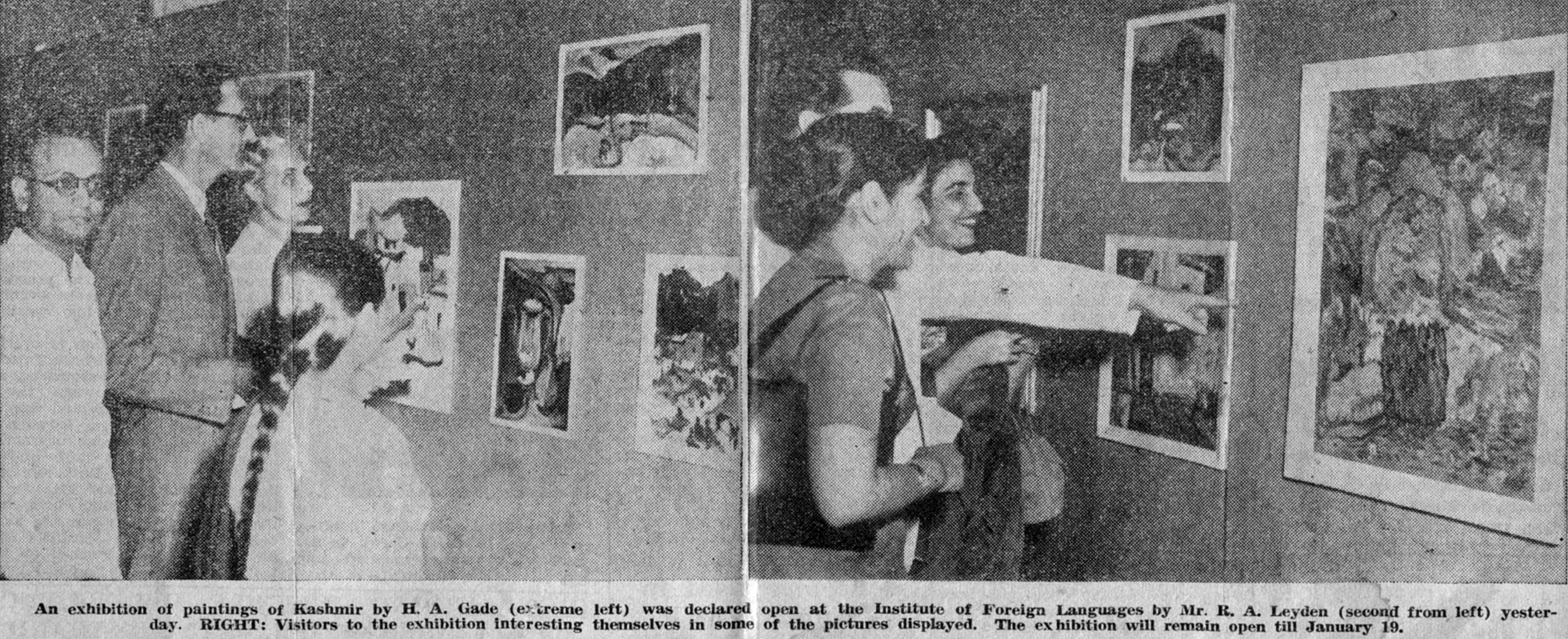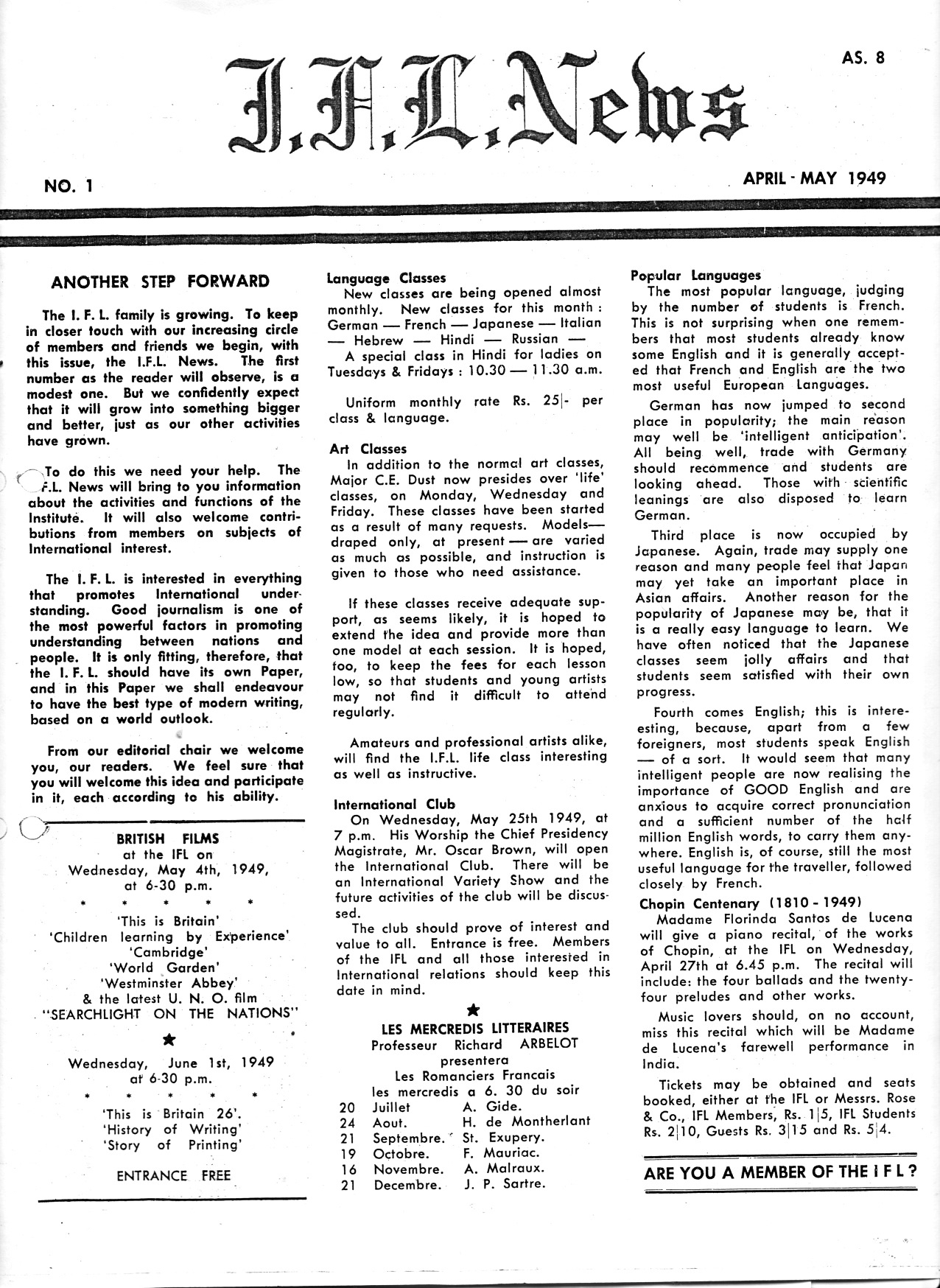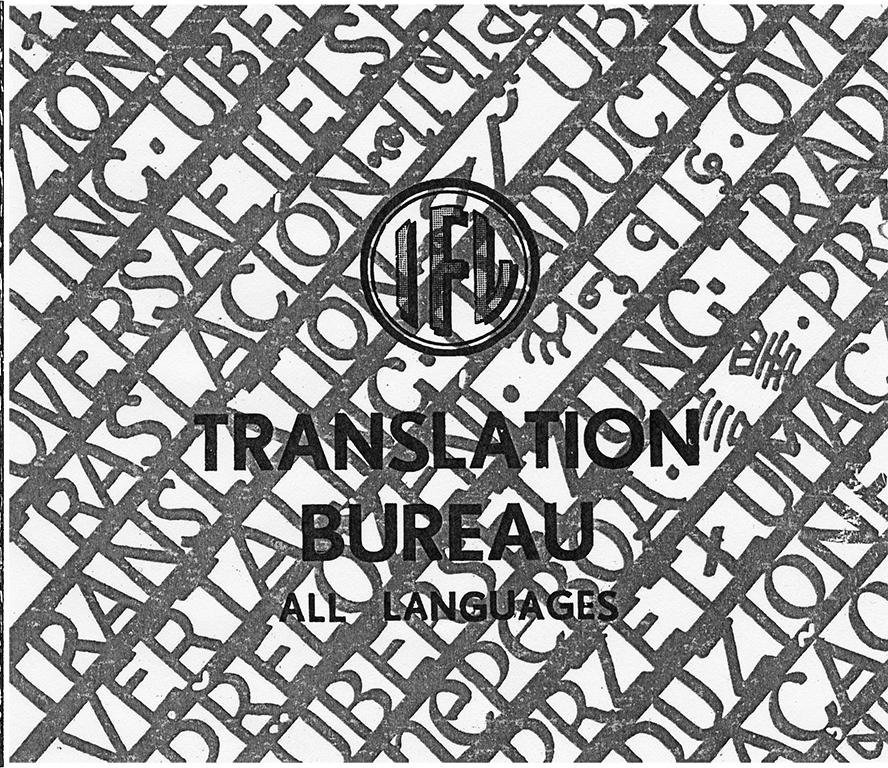Archive
https://archive.metromod.net/viewer.p/69/2951/object/5145-8100804
Archive
Institute of Foreign Languages
- Institute of Foreign Languages
IFL, I.F.L.
- Language SchoolExhibition SpaceLibraryTheatre
With its wide range of cultural activities, the Institute of Foreign Languages − founded in 1946 by the Viennese emigrant Charles Petras − became a glocal contact zone in Bombay.
Word Count: 27
Menkwa Building, Outram Road, Fort, Bombay (now Buddha Bhavan, Purshotamdas Thakurdas Marg, Fort, Mumbai) (1946–1950).
Jehangir Building, 133 Mahatma Gandhi Road, Kala Ghoda, Fort Bombay (now Mumbai) (1950–1959).
Invitation to IFL International Club, 1949 (IFL News, vol. 1, no. 2, June–July 1949, p. 2. Archive Margit Franz © Musée Ianchelevici La Louviére, Archive). 
Former site of IFL, Jehangir Building, 1950–1959, entrance (Photo: Margit Franz, 2018). 
Former site of IFL, Jehangir Building, 1950–1959, street view (Photo: Margit Franz, 2018). 
Press images of Gade’s solo exhibition at the Institute of Foreign Languages, January 1951. Photo left: H.A. Gade (from left), Albrecht von Leyden, Margit von Leyden, unknown. Photo right: unknown woman (from left), Walter Langhammer, Khorshed Gandhy (© Private Archive James von Leyden, Lewes). 
Cover of the first edition of IFL News, April-May 1949 (IFL News, vol.1, no. 1, April-May 1949, p. 1. Private Archive Margit Franz © Musée Ianchelevici Archive, La Louviére). 
Advertisement for the IFL Language Bureau, 1949 (IFL News, vol. 1, no. 2, June–July 1949, p. 8. Private Archive Margit Franz © Musée Ianchelevici Archive, La Louviére). Anonymous. “New Club in Bombay: Unrestricted Membership.” The Times of India, 26 May 1949, p. 3.
Art Critic. “Child Art From Ceylon.” The Times of India, 25 April 1950, p. 3.
Bernstein, Lina. Magda Nachman: An Artist in Exile (Modern Biographies). Academic Studies Press, 2020.
Chatterji, R. “Raza’s Farewell Show.” The Times of India, 17 September 1950, p. 11.
Franz, Margit. “Exile meets Avantgarde: ExilantInnen-Kunstnetzwerke in Bombay.” Going East – Going South. Österreichisches Exil in Asien und Afrika, edited by Margit Franz and Heimo Halbrainer, CLIO, 2014, pp. 403–431. Academia, www.academia.edu/49079321/Exile_meets_Avantgarde_ExilantInnen_Kunstnetzwerke_in_Bombay. Accessed 16 June 2021.
Franz, Margit. Gateway India. Deutschsprachiges Exil in Indien zwischen britischer Kolonialherrschaft, Maharadschas und Gandhi. CLIO 2015 (especially chapter: 6.1. Kunstvermittlung: Das Institute for Foreign Languages von Charles Petras als interkulturelles Kultur- und Kunstzentrum, pp. 248–265. Academia, www.academia.edu/49273939/6_1_Kunstvermittlung_Das_Institute_for_Foreign_Languages_von_Charles_Petras_als_interkulturelles_Kultur_und_Kunstzentrum. Accessed 17 June 2021.)
Franz, Margit. “From Dinner Parties to Galleries: The Langhammer-Leyden-Schlesinger Circle in Bombay – 1940s through the 1950s.” Arrival Cities. Migrating Artists and New Metropolitan Topographies in the 20th Century, edited by Burcu Dogramaci et al., Leuven University Press, 2020, pp. 73–90. Project Muse, doi: 10.1353/book.77990. Accessed 30 March 2021.
Word Count: 186
Hilde Holger Archive, by Primavera Boman-Behram, London.
Musée Ianchelevici Archives, La Louviére.
Private Archive Margit Franz, Sinabelkirchen.
Private Archive James von Leyden, Lewes.
The Times of India (Mumbai) Archive, via Staatsbibliothek zu Berlin:
http://erf.sbb.spk-berlin.de/historical-newspapers/. Accessed 30 March 2021.Word Count: 43
- 1946
- 1959
Charles Petras, H.A. Gade, M.F. Husain, Idel Ianchelevici, Walter Langhammer, S.H. Raza, Magda Nachmann, Rudolf von Leyden.
- Bombay
- Margit Franz; Mareike Schwarz. "Institute of Foreign Languages." METROMOD Archive, 2021, https://archive.metromod.net/viewer.p/69/2951/object/5145-8100804, last modified: 05-08-2021.
-
Magda Nachman AcharyaArtistTheatre DesignerIllustratorTeacherBombay
The political turmoil of the twentieth century took Magda Nachman from St. Petersburg to Moscow to the Russian countryside, then to Berlin during the 1920s and 1930s and, finally, to Bombay.
Word Count: 31
Charles PetrasJournalistDirectorLanguage TeacherWriterTheatre MakerArt ManagerTranslatorBombayCharles Petras was the founder and director of the international cultural centre Institute of Foreign Languages, an avant-garde theatre director and a very active promoter of international understanding and world peace.
Word Count: 31
Marg. A Magazine of Architecture and ArtMagazineBombayLocal and exiled creatives formed the Modern Architectural Research Group to publish a progressive journal of art and architecture in Bombay from 1946 onwards.
Word Count: 23
The Feldberg Art Collection. A Series of Three Exhibitions of European Artworks collected by the Feldberg FamilyExhibitionBombayIn 1950 the Institute of Foreign Languages organised three exhibitions of paintings from the collection of the exiled Jewish manufacturer Siegbert Feldberg and his wife Hildegard from Stettin.
Word Count: 27
Rudolf von LeydenGeologistAdvertisement SpecialistJournalistArt CriticArt CollectorCartoonistBombayThe advertisement expert, Rudolf von Leyden, became a major art critic and art historian in Bombay in the 1940s, advocating an urgent need for modernism in art in post-colonial India.
Word Count: 30
Emanuel SchlesingerFactory OwnerTechnical DirectorArt CollectorArt CriticBombayThe art collector Schlesinger provided primarily financial aid by creating working opportunities for young artists in post-independence Bombay, and initiated the corporate culture of buying art.
Word Count: 26
Bombay Art SocietyAssociationBombayOne of the oldest art societies in India founded by colonial rulers, Bombay Art Society showcased art students and professional artists from all over India, including the Progressive Artists of Bombay.
Word Count: 31
Iconic Photo of the Progressive Artists’ Group and Their AssociatesPhotographBombayThere are two versions of the PAG photo at the opening of M.F. Husain's first solo exhibition in 1950 (published in 1996 and 2003) and two narratives about the opening.
Word Count: 28
Open Studio Evenings by Käthe and Walter LanghammerSalonBombayThe painter Walter Langhammer and his wife Käthe built an informal infrastructure to promote local avant-garde artists and regularly invited them to Open Studio Evenings at their studio.
Word Count: 29